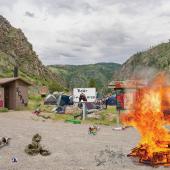Beetle-Kill Lumber
Everyone's talking about it, and we've all noticed the large portions of our lush green hillsides blotted with unsightly stands of dry, reddish-brown trees. Thanks to the mountain pine beetle (Dendroctonus ponderosae) and the recent trend of warmer-than-normal winters, these stands of dead trees, primarily the whitebark, lodgepole, Ponderosa, and sugar pine, are creating extreme fire hazards and a host of related environmental problems.
Enter Neil Wilbert of Beetlekill Boards. Instead of seeing an eyesore, he sees an opportunity to provide builders and craftsmen with unique, local lumber and reduce the fire hazard on private and public lands. "I'm still finding uses for this colorful, blue-stained wood," says Wilbert, who's been a builder for 30 years. "It makes beautiful furniture, trim, and doors."
Wilbert's reclamation and low-impact tree removal (he uses a small skidder and mills on-site) turns these seemingly worthless trees into usable lumber. The wood's unique color is a product of a blue-stain fungi introduced by the beetles. Ultimately, the tree succumbs to the fungi and dies, with no apparent harm to the wood.
The best part, says Wilbert, is the sustainable nature of such a harvest. "No additional logging roads are needed to harvest these trees, and it is a local product," he explains. "I think progressive builders and the Bozeman community will see the big-picture value of beetle-killed lumber and get behind this stuff."
In the Gallatin Valley, using rustic, reclaimed materials for remodeling and new construction has been popular for years. Wilbert's recent projects utilizing beetle-killed lumber include garden sheds, pergolas, furniture, and even flooring. In addition, working with "blue pine" can be more cost-effective and maintain a smaller carbon footprint by using local resources. Other reclaimed materials can require additional labor for transport, cleaning, de-nailing, and re-milling, along with inherent waste.
Currently, Wilbert is only harvesting beetlekill on private land in the Bridgers, but hopes that both federal and state foresters will see the potential of beetle-kill logging.













